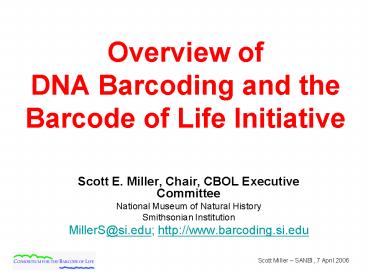Overview of DNA Barcoding and the Barcode of Life Initiative - PowerPoint PPT Presentation
1 / 18
Title:
Overview of DNA Barcoding and the Barcode of Life Initiative
Description:
... in taxonomy is not new; but large-scale and standardization are new. NEVERTHELESS, Barcoding is helping to create a 21st century research environment for taxonomy ... – PowerPoint PPT presentation
Number of Views:204
Avg rating:3.0/5.0
Title: Overview of DNA Barcoding and the Barcode of Life Initiative
1
Overview of DNA Barcoding and the Barcode of
Life Initiative
- Scott E. Miller, Chair, CBOL Executive Committee
- National Museum of Natural History
- Smithsonian Institution
- MillerS_at_si.edu http//www.barcoding.si.edu
2
Poor representation of systematics infrastructure
in Africa
3
Human resources also thinly distributed
- Stuckenberg (1964) most systematics done outside
of Africa, but only 7 of world entomologists
working on Africa - Gaston May (1992) only 4 of ecologists 7
of systematists in Africa - Surveys by CABI (1993), ICIPE (1996), SAFRINET
(1998) show same trends
4
Outreach to Africa
- South Africa and Kenya involved from beginning of
CBOL in May 2004 - Southern African regional workshop now
- Eastern and Western regional workshops under
discussion - African involvement in global campaigns (e.g.,
birds, fish, mosquitos, fruit flies)
5
Reactions to Barcoding 2004
- From ecologists and other users This is what
we need! How soon can we get started? - From traditional taxonomists Species should be
based on lots of characters, not just barcodes
- From forward-looking taxonomists Using
molecular data as species diagnostics isnt new,
but standardization and broad implementation are
great! - From barcoding practitioners I had my doubts
at the beginning, but it really works as a tool
for identification (96 accurate in a recent
mollusc paper) and it is at least as good as
traditional approaches to discovering new
species.
6
A DNA barcode is a short gene sequence taken
from standardized portions of the genome, used
to identify species
7
The Mitochondrial Genome
8
Uses of DNA Barcodes
- Applied tool for identifying regulated species
- Disease vectors, agricultural pests, invasives
- Environmental indicators, protected species
- Research tool for assigning specimens to known
species, including - Life history stages, damaged specimens, gut
contents, droppings - Triage tool for flagging potential new species
- Undescribed and cryptic species
9
Species Identification Matters
- Endangered/protected species
- Agricultural pests
- Invasive species
- Disease vectors/pathogens
- Hazards (e.g., bird strikes on airplanes)
- Environmental quality indicators
- Unsustainable harvesting
- Fidelity of cell lines/culture collections
10
Uses of DNA Barcodes
- Research tool for assigning specimens to known
species, including - Life history stages, damaged specimens, gut
contents, droppings
11
Uses of DNA Barcodes
- Applied tool for identifying regulated species
- Disease vectors, agricultural pests, invasives
- Environmental indicators, protected species
- Research tool for assigning specimens to known
species, including - Life history stages, damaged specimens, gut
contents, droppings - Triage tool for flagging potential new species
- Undescribed and cryptic species
- 23 marine species in Pearl Harbor are alien or
cryptogenic
12
What DNA Barcoding is NOT
- Barcoding is not DNA taxonomy no single gene (or
character) is adequate - Barcoding is not Tree of Life barcode clusters
are not phylogenetic trees - Barcoding is not just COI standardizing on one
region has benefits and limits - Molecules in taxonomy is not new but large-scale
and standardization are new - NEVERTHELESS, Barcoding is helping to create a
21st century research environment for taxonomy
13
Wider Impacts of Barcoding 2008
- Catalyzing interoperability of databases
- Barcode data standards link sequences, specimens,
species names and publications - Renewing the mission of museums
- DNA recovery from formalin-fixed specimens
- Promoting the growth of DNA banks
- Expanding analytical toolbox for taxonomy
- Improving the information infrastructure
- Digital library initiative in taxonomy
14
Digitizing Taxonomic Literature
- CBOLs catalytic efforts
- Library-Laboratory meeting in London on
electronic access to taxonomic literature - Led to formation of Biodiversity Heritage Library
initiative - Proactive steps with PubMed to add taxonomic
journals to online abstracts - Aggressive negotiation with publishers of
barcoding papers
15
The Vision Enabling research, product
development, and dissemination
- Ideally, all data should be accessible
- From any location
- In formats appropriate to users
- With a single query for each data type
- Using simple links
- Interoperable across data sets
- digitally
16
Species web pages
17
Collaborating with International Initiatives
- Global Biodiversity Information Facility (GBIF)
- Global Taxonomy Initiative (GTI) of Convention on
Biological Diversity - BioNet International
- Projects such as SABONET
- Digital library
- Genbank/EMBL/DDBJ
- Leveraging north and south funding?
18
Planned Outreach
- Regional meetings in
- Cape Town, South Africa, 7-8 April 2006, SANBI
- Brazil, 2nd quarter 2006
- Southern Asia, mid-2007
- Nairobi, Kenya, October 2006
- Second International Barcode Conference
- Southeast Asia, February 2007
- Support from CBOL, host governments and
international development agencies































